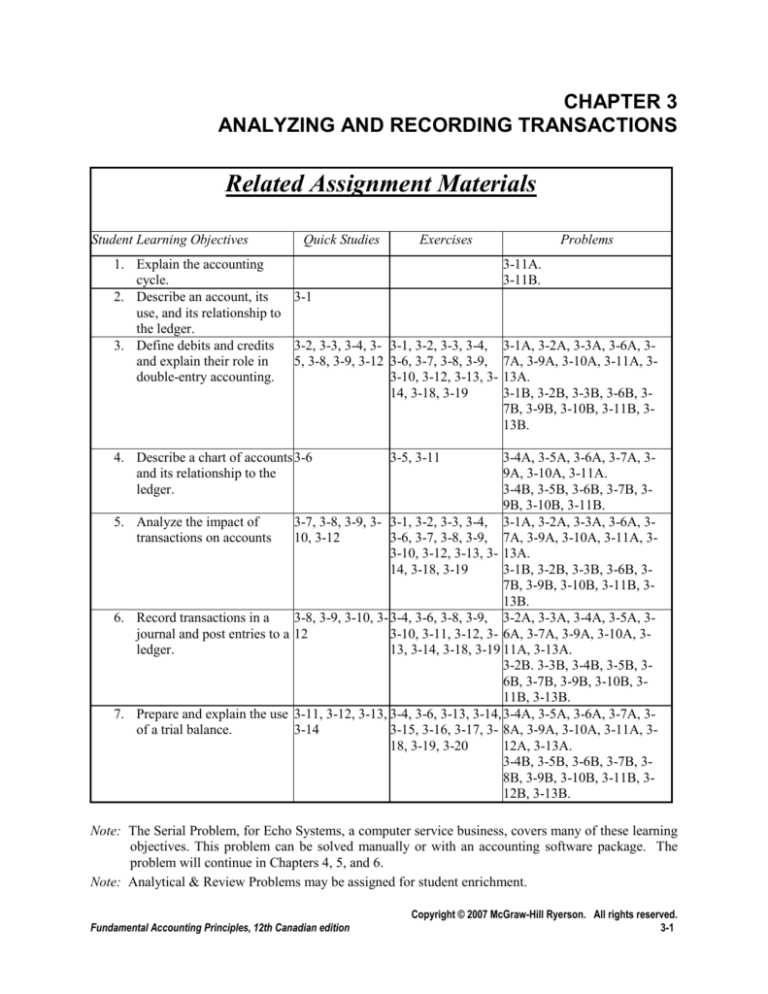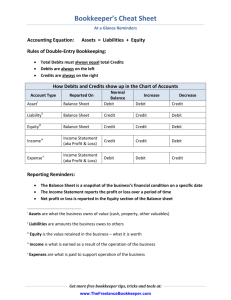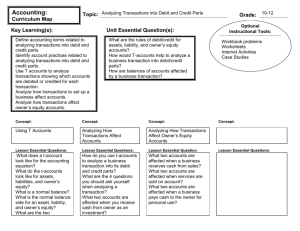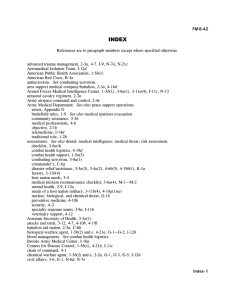
CHAPTER 3
ANALYZING AND RECORDING TRANSACTIONS
Related Assignment Materials
Student Learning Objectives
Quick Studies
Exercises
1. Explain the accounting
cycle.
2. Describe an account, its
3-1
use, and its relationship to
the ledger.
3. Define debits and credits 3-2, 3-3, 3-4, 3- 3-1, 3-2, 3-3, 3-4,
and explain their role in
5, 3-8, 3-9, 3-12 3-6, 3-7, 3-8, 3-9,
double-entry accounting.
3-10, 3-12, 3-13, 314, 3-18, 3-19
4. Describe a chart of accounts 3-6
and its relationship to the
ledger.
Problems
3-11A.
3-11B.
3-1A, 3-2A, 3-3A, 3-6A, 37A, 3-9A, 3-10A, 3-11A, 313A.
3-1B, 3-2B, 3-3B, 3-6B, 37B, 3-9B, 3-10B, 3-11B, 313B.
3-5, 3-11
3-4A, 3-5A, 3-6A, 3-7A, 39A, 3-10A, 3-11A.
3-4B, 3-5B, 3-6B, 3-7B, 39B, 3-10B, 3-11B.
5. Analyze the impact of
3-7, 3-8, 3-9, 3- 3-1, 3-2, 3-3, 3-4, 3-1A, 3-2A, 3-3A, 3-6A, 3transactions on accounts
10, 3-12
3-6, 3-7, 3-8, 3-9, 7A, 3-9A, 3-10A, 3-11A, 33-10, 3-12, 3-13, 3- 13A.
14, 3-18, 3-19
3-1B, 3-2B, 3-3B, 3-6B, 37B, 3-9B, 3-10B, 3-11B, 313B.
6. Record transactions in a
3-8, 3-9, 3-10, 3- 3-4, 3-6, 3-8, 3-9, 3-2A, 3-3A, 3-4A, 3-5A, 3journal and post entries to a 12
3-10, 3-11, 3-12, 3- 6A, 3-7A, 3-9A, 3-10A, 3ledger.
13, 3-14, 3-18, 3-19 11A, 3-13A.
3-2B. 3-3B, 3-4B, 3-5B, 36B, 3-7B, 3-9B, 3-10B, 311B, 3-13B.
7. Prepare and explain the use 3-11, 3-12, 3-13, 3-4, 3-6, 3-13, 3-14, 3-4A, 3-5A, 3-6A, 3-7A, 3of a trial balance.
3-14
3-15, 3-16, 3-17, 3- 8A, 3-9A, 3-10A, 3-11A, 318, 3-19, 3-20
12A, 3-13A.
3-4B, 3-5B, 3-6B, 3-7B, 38B, 3-9B, 3-10B, 3-11B, 312B, 3-13B.
Note: The Serial Problem, for Echo Systems, a computer service business, covers many of these learning
objectives. This problem can be solved manually or with an accounting software package. The
problem will continue in Chapters 4, 5, and 6.
Note: Analytical & Review Problems may be assigned for student enrichment.
Fundamental Accounting Principles, 12th Canadian edition
Copyright © 2007 McGraw-Hill Ryerson. All rights reserved.
3-1
Instructor’s Notes
Chapter Outline
I.
II.
III.
The Accounting Cycle
The steps followed in preparing financial statements. Emphasize that
this is a process which is consistently followed.
Accounts
A. An account is a detailed record of increases and decreases in a
specific asset, liability, equity, revenue or expense item.
B. There should be a separate account for each item on the income
statement and balance sheet. The major types of accounts are:
1. Asset accounts, including Cash, Accounts Receivable, Notes
Receivable, Prepaid Expenses, Supplies, Equipment,
Buildings, and Land.
Examples: Cash (on hand and in bank), Receivables, Prepaid
Expenses, (insurance, rent, taxes office supplies, store
supplies) Equipment, Buildings, Land.
Note: Ask students to describe some transactions that would
involve Accounts Receivable.
2. Liability accounts
Payables, Accounts Payable, Notes Payable, Mortgage
Payable.
Unearned Revenue Unearned Rent, Unearned Subscriptions,
Unearned Professional Fees.
Note: The realization principle and how it relates to revenue
versus unearned revenues and expense versus prepaid
expense can be reviewed.
3. Equity Accounts, including Owner Capital, Owner
Withdrawals, and a separate account for each type of Revenue
and Expense found in the business entity.
The chart of accounts is a list of all the accounts.
Analyzing Transactions
A T-account is helpful learning tool that represents an account in the
ledger. It shows the effects of transactions and events on specific
accounts.
1. The left side of an account is called the debit side. A debit is
an entry on the left side of an account.
2. The right side of an account is called the credit side. A credit
is an entry on the right side of an account.
3. An account balance is the difference between the increases
and decreases recorded in account.
4. The account balance is the difference between the increases
(including the beginning balance) and decreases recorded in
an account
1. Assets are on the left side of the equation therefore the left or
Copyright © 2007 McGraw-Hill Ryerson. All rights reserved.
3-2
Fundamental Accounting Principles, 12th Canadian edition
Instructor’s Notes
Chapter Outline
debit side is the normal balance for assets. Liabilities and
equities are on the right side therefore the right or the credit
side is the normal balance for liabilities and equity.
2. Withdrawals, revenues, and expenses really are changes in
owner’s equity but it is necessary to set-up temporary accounts
for each of these items to accumulate data for statements.
Withdrawals and expense accounts really represent decreases
in owner’s equity therefore they are assigned debit balances.
Revenue accounts really represent increases in owner’s equity
therefore they are assigned credit balances.
C. Double-entry accounting is an accounting system that records the
effects of transactions and other events in at least two accounts
with equal debts and credits. The total amount debited must equal
the total amount credited. Therefore, the sum of the debit account
balances in the ledger must equal the sum of the credit account
balances. (Note: It is extremely important for students to practice
analyzing each of the basic transactions into debits and credits.)
Note: It is crucial that students understand basic debit-credit
theory. After introducing the Rules, illustrative
transactions can be presented by:
Analyzing the transaction
Determining the types of accounts affected (asset, liability,
owner's equity, revenue, expense)
Determining which accounts increase and/or decrease
Converting the increase/decrease to debit/credit.
Note: The words to debit and to credit should not be confused
with to increase and to decrease.
IV. Recording and Posting Transactions
A. To help avoid errors, accounting systems first record transactions
in a journal. The process of recording the transactions in a journal
is called journalizing.
B. A General Journal is the most flexible type of journal because it
can be used to record any type of transaction. A journal entry that
affects more than two accounts is called a compound journal entry.
Each journal entry must contain equal debits and credits.
A general journal entry will include:
1.
Date of the transaction
2.
Titles of affected accounts
3.
Dollar amount of each debit and credit
4.
Explanation
C. Posting is the process of copying journal entry information from
the journal to the accounts in the ledger. Actual accounting
systems use balance column accounts rather than T-accounts in the
Fundamental Accounting Principles, 12th Canadian edition
Copyright © 2007 McGraw-Hill Ryerson. All rights reserved.
3-3
Instructor’s Notes
Chapter Outline
VI.
ledger. A balance column account has debit and credit columns for
recording entries and a third column for showing the balance of
the account after each entry is posted. It is possible for accounts to
have abnormal balances.
The posting process is commonly done using a computer program. .
The Trial Balance
A. A trial balance is a summary of the ledger that lists the accounts
and their balances. The total debit balances should equal the total
credit balances.
B. One purpose for preparing a trial balance is to test for the equality
of the debit and credit account balances. Another reason is to
simplify the task of preparing the financial statements.
C. When a trial balance does not balance (the columns are not equal),
an error has occurred in one of the following steps:
1. Preparing the journal entries
2. Posting the journal entries to the ledger.
3. Calculating account balances.
4. Copying account balances to the trial balance.
5. Totaling the trial balance columns.
Any errors must be located and corrected before preparing the
financial statements.
Note: Correcting errors
1. Errors must be corrected. Do not erase journal entries or
postings in accounts. This may indicate an effort to conceal
something.
2. Errors discovered before posting or incorrect amount posted—
correct by ruling a single line through the incorrect data and
writing in the correct data.
3. Incorrect account posted—records a correcting journal entry,
which requires a complete explanation.
Note: Formatting conventions:
1. Commas to indicate thousands of dollars and decimal points to
separate dollars and cents are not necessary except on unruled
paper.
2. Dollar signs are not used in journals and ledgers but are
required on financial reports—before the first amount in each
column of figures and before the first amount appearing after a
ruled line that indicates an addition or subtraction.
Copyright © 2007 McGraw-Hill Ryerson. All rights reserved.
3-4
Fundamental Accounting Principles, 12th Canadian edition
VISUAL #3-1
THREE PARTS OF AN ACCOUNT
(1) ACCOUNT TITLE
Left Side
Right Side
Called
Called
(2) DEBIT
(3) CREDIT
Rules for using accounts
Accounts are assigned balance sides (Debit or Credit)
To increase any account, use the balance side
To decrease any account, use the side opposite the balance
Finding account balances
If total debits = total credits, the account balance is zero.
If total debits are greater than total credits, the account has a debit
balance equal to the difference of the two totals.
If total credits are greater than total debits, the account has a
credit balance equal to the difference of the two totals.
Fundamental Accounting Principles, 12th Canadian edition
Copyright © 2007 McGraw-Hill Ryerson. All rights reserved.
3-5
VISUAL #3-2
REAL ACCOUNTS
ALL ACCOUNTS ARE ASSIGNED BALANCE SIDES
BALANCE SIDES FOR ASSETS, LIABILITIES, AND
EQUITY ACCOUNTS ARE ASSIGNED BASED ON
SIDE OF EQUATION THEY ARE ON.
ASSETS
=
LIAB + OWNER’S
EQUITY
are on the
left side of the equation
therefore they are
are on the
right side of the equation
therefore they are
ASSIGNED LEFT SIDE
BALANCE
ASSIGNED RIGHT SIDE
BALANCE
DEBIT BALANCE
CREDIT BALANCE
All Asset Accts
Normal
Debit
Credit
Balance
+ side
- side
All Liability Accts
Normal
Debit Credit
Balance
- side + side
All Equity Accts
Normal
Debit
Credit
Balance
- side
+ side
*In a sole proprietorship, there is only one owner’s equity account, which is
called capital. For that reason, the terms equity and capital are often used
interchangeably. When corporations are discussed in detail, you will learn
many (shareholder’s) equity accounts. Owner’s equity is an account
classification like assets. Owner’s name, capital, is the account title.
Copyright © 2007 McGraw-Hill Ryerson. All rights reserved.
3-6
Fundamental Accounting Principles, 12th Canadian edition
VISUAL #3-3
TEMPORARY ACCOUNTS
Temporary accounts are established to facilitate efficient accumulation of
data for statements. Temporary accounts are established for withdrawals,
each revenue and each expense. Temporary accounts are assigned balances
based on how they affect equity.
(Equity Account)
Owner’s Name, Capital
Debit
Credit Balance
- side
+ side
Effect on equity? OE or OE
OE = Dr
OE = Cr
OE = Dr
Temporary Accounts
Owner, Withdrawals*
Revenues
Expenses
All Withdrawal Accts
Normal
Debit
Credit
Balance
+ side
- side
All Revenue Accts
Normal
Debit
Credit
Balance
- side
+ side
All Expense Accts
Normal
Debit
Credit
Balance
+ side
- side
Note:
Transactions during the period always increase the balances of these
temporary accounts since the transaction represent additional withdrawals,
revenues, and expenses. We will later learn how to move these amounts
back to the real account they affect CAPITAL. At the end of the
accounting period, transferring withdrawals, revenues and expenses back to
capital is the main use for the decrease side of the temporary accounts.
*The “owner’s name, withdrawals” is the account title and the classification
of account is a contra-equity.
Fundamental Accounting Principles, 12th Canadian edition
Copyright © 2007 McGraw-Hill Ryerson. All rights reserved.
3-7
VISUAL #3-4
USING ACCOUNTS - SUMMARY
Real Accounts
All Asset Accts
Debit +
Balance
All Liability Accts
Credit +
Balance
All Equity Accts
Credit +
Balance
RULE REVIEW
Temporary Accounts
Transaction analysis rules
Each transaction affects at least 2
accounts.
Each transaction must have equal
debits and credits
General account use rules
To increase any account, use balance
side.
To decrease any account, use side
opposite the balance
All Withdrawal
Accounts
Debit +
Balance
All Revenue Accounts
Credit +
Balance
All Expense Accounts
Debit +
Balance
Copyright © 2007 McGraw-Hill Ryerson. All rights reserved.
3-8
Fundamental Accounting Principles, 12th Canadian edition
Alternate Demo Problem Chapter Three
Wigor Company was organized by Bill Wiggins.
transactions were completed in 2011.
The following
a. Bill Wiggins paid in $30,000 to start the business.
b. Equipment for use in the business was purchased for $9,000.
Two-thirds of the price was paid in cash; the rest was due in a
year.
c. Service fees earned were $60,000; $6,000 of this was on credit.
d. Operating expenses incurred were $35,000; $4,000 was on
credit.
e. Half the money owed to Wigor Co. was collected.
f. Two thousand dollars owed by Wigor Co. was paid off.
g. Wiggins bought a car for $12,000 for his personal use, half
paid for now from his personal savings and half to be paid in a
year.
Required:
1.
Provide journal entries for each of the events.
2.
Prepare a trial balance at the end of the year for the Wigor
Company.
Fundamental Accounting Principles, 12th Canadian edition
Copyright © 2007 McGraw-Hill Ryerson. All rights reserved.
3-9
Solution: Alternate Demo Problem Three
1.
a.
b.
c.
d.
e.
f.
g.
Cash..................................................
Bill Wiggins, Capital ...................
Dr.
30,000
Cr.
30,000
Equipment ........................................
Cash ............................................
Accounts Payable ......................
9,000
Cash..................................................
Accounts Receivable.......................
Service Fee Earned ....................
54,000
6,000
Operating Expenses ........................
Cash ............................................
Accounts Payable ......................
35,000
Cash..................................................
Accounts Receivable .................
3,000
Accounts Payable ............................
Cash ............................................
2,000
6,000
3,000
60,000
31,000
4,000
3,000
2,000
No entry because this is a personal
transactions
Copyright © 2007 McGraw-Hill Ryerson. All rights reserved.
3-10
Fundamental Accounting Principles, 12th Canadian edition
WIGOR COMPANY
Trial Balance
December 31, 2011
Dr.
Cash ....................................................................
Accounts receivable ..........................................
Equipment ..........................................................
Accounts payable ..............................................
Bill Wiggins, capital ...........................................
Service fees earned ...........................................
Operating expenses...........................................
Totals ..................................................................
Fundamental Accounting Principles, 12th Canadian edition
11
Cr.
$48,000
3,000
9,000
35,000
$95,000
$ 5,000
30,000
60,000
______
$95,000
Copyright © 2007 McGraw-Hill Ryerson. All rights reserved.
3-









